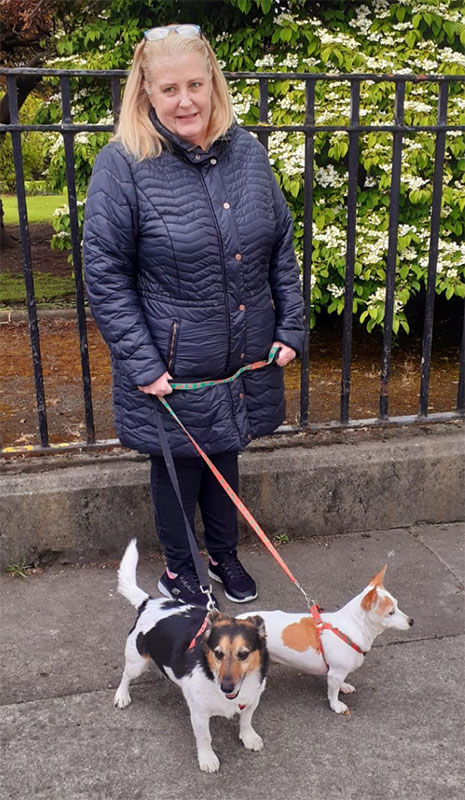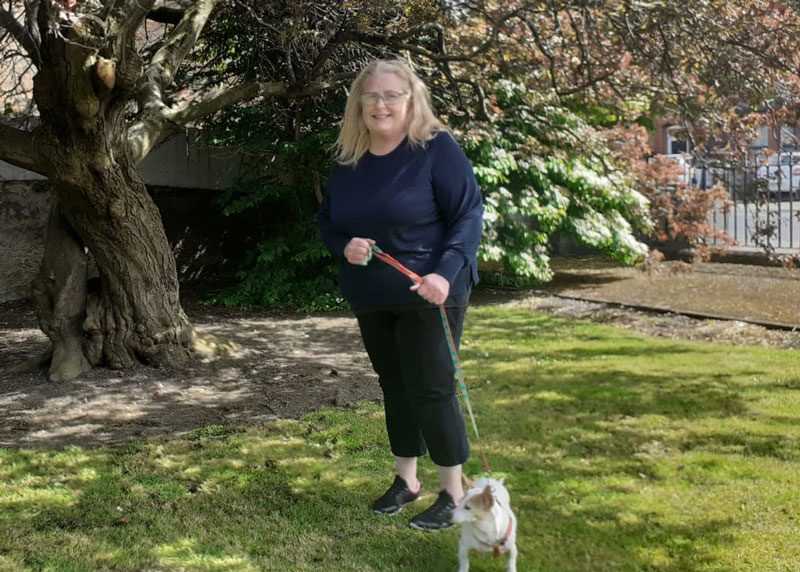Letitia Swardt from Ireland
Treatment details:
Age at treatment: 58
Hospital: Mater Hospital, Dublin, Ireland
Date of procedure: February, 2021

Life Before Zephyr® Valves:
I’m an independent, outdoorsy person with a happy disposition. Before I became unwell, I always worked. At first in admin and secretarial roles, and for 10 years as a childminder.
I was always on the go — I loved to be busy. You’d find me at the beach, swimming, or barbecuing, or going for long walks.
I think it’s important to look at things positively in life, and I pride myself on being a trier — I don’t give up easily. But my illness has made maintaining this outlook tough. Emphysema can take away your independence and, I must say, I’ve found that so difficult.
I came to Ireland from South Africa in 2005. In 2010, I started feeling unwell. I couldn’t breathe properly when I was walking, and I had a series of chest infections. I assumed it was to do with my weight. My breathlessness kept getting worse, so I decided to get it checked out.
I saw my GP and they referred me straight to a respiratory specialist. I was diagnosed with severe COPD.
My dad and sister both had emphysema, but I didn’t click that severe COPD was the same thing. When I realised, I was petrified. I started getting my will in order, and making plans in case the worst were to happen. It felt like my life was over.
My breathlessness meant I couldn’t walk up the stairs easily. I couldn’t walk far at all. I used to lean over the kitchen sink to do the dishes, standing up straight was too tiring. I couldn’t do basic things like washing my hair in the shower without getting completely out of breath.
Some people found it hard to understand what I was going through. I would cancel plans because I was simply too exhausted. I think they thought I was attention seeking. That made me miserable. I guess it’s hard to understand unless you’ve been through something like it.
I stopped smoking six years ago and started trying to lose weight, hoping I’d lose enough weight to be eligible for a surgical lung reduction. But I still didn’t quite qualify.
Then I heard about Zephyr Valve treatment which sounded like a great option. Professor Karen Redmond did some tests to see if I was eligible. Fortunately, I was! I was so relieved.
Unfortunately, that was when COVID hit, and everything was put on pause. I started to worry I wouldn’t get to have the procedure, but then I got a surprise call in February 2021 and was told I could have the procedure two days later.
I was delighted! I told them, YES, anything to breathe easier, I would be there. I wasn’t letting this opportunity go.
Life With Zephyr Valves:
Professor Karen Redmond carried out my Zephyr Valve procedure in February 2021. I was 58. I must say, I was quite scared before the procedure, but my doctor did a great job of reassuring me.
The procedure went well. I was a bit sore after the anesthetic, so Professor Redmond told me to take it easy that day. The next day, the physiotherapist came and helped me to start walking.
I did a few laps of the hospital, and I already felt so much better. I could breathe deeply. I couldn’t believe my luck! I did lots of other exercises, like blowing the ball and the flutter test. I felt a bit tired, but the more I did the exercises, the better my breathing got.
After four days, I was able to go home. I kept up with my rehab exercises, and I kept walking. My recovery has gone well — there are highs and lows, as is to be expected. Some days I’m still a little breathless. But overall, my breathing is so much better and I can do so much more.
I can walk further without stopping. I’m able to walk my dogs around the block with no bother! I can shower without feeling out of breath. Carrying my shopping is still a bit of a challenge, but I am confident it will come in time.
I feel like I’m on the way to regaining my independence, my dignity and my self respect. I’ve got the confidence to go out again and socialise, without feeling embarrassed about my breathlessness.
I plan to go back to work soon. Doing something for myself and earning my own money is so important to me. I want to go back into admin or secretarial work. An office job would do me nicely.
What would I say to anyone with severe emphysema who is eligible for the Zephyr Valves?
Don’t be afraid to do it!

What is the Zephyr Valve procedure?
The Zephyr Valve is intended for the treatment of patients with severe emphysema – a form of COPD. A physician uses a bronchoscope to place on average 4 tiny valves in the airways to block off the damaged areas of the lungs so air no longer gets trapped there. No cutting or incision is required and the procedure is usually completed in under an hour.
The valve placement allows the healthier parts of the lungs to expand and relieves the pressure on the diaphragm, which decreases shortness of breath and makes breathing easier. Patients report being able to take full breaths immediately after the procedure and within a few days are back to doing everyday tasks with more ease.
The results of case studies do not necessarily allow conclusions to be drawn in other cases. Results in other cases can be different. Possible complications associated with the endobronchial valve treatment include: Pneumothorax, deterioration of the COPD symptoms, pneumonia, dyspnea and in rare cases death. The Zephyr® Endobronchial Valve is an implantable bronchial valve intended to control airflow in order to improve lung functions in patients with hyperinflation associated with severe emphysema and/or to reduce air leaks. The Zephyr Valve is contraindicated for: Patients for whom bronchoscopic procedures are contraindicated; Evidence of active pulmonary infection; Patients with known allergies to Nitinol (nickel-titanium) or its constituent metals (nickel or titanium); Patients with known allergies to silicone; Patients who have not quit smoking. Use is restricted to a trained physician. Prior to use, please reference the Zephyr Endobronchial System Instructions for more information on indications, contraindications, warnings, all precautions, and adverse events.
